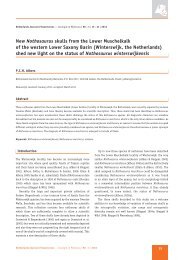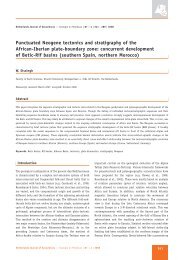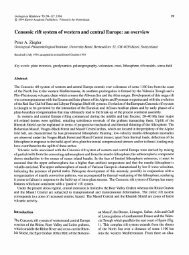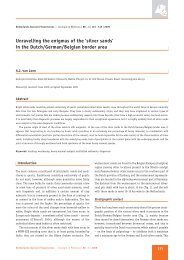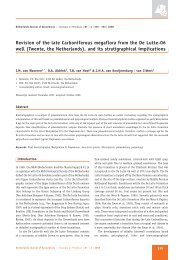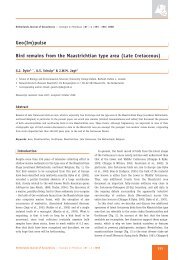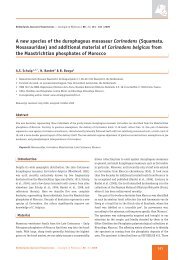Diagnostic sedimentary structures of the fluvial-tidal transition zone ...
Diagnostic sedimentary structures of the fluvial-tidal transition zone ...
Diagnostic sedimentary structures of the fluvial-tidal transition zone ...
Create successful ePaper yourself
Turn your PDF publications into a flip-book with our unique Google optimized e-Paper software.
Fig. 4. Historical map showing <strong>the</strong> complicated system <strong>of</strong> <strong>tidal</strong> inlets and <strong>fluvial</strong> distributaries in <strong>the</strong> SW part <strong>of</strong> Holland in <strong>the</strong> middle <strong>of</strong> <strong>the</strong> 16th<br />
century. The inset measures about 26 x 18 km (Map made by Jacob van Deventer,1558).<br />
Features <strong>of</strong> <strong>the</strong> X-bedded sets<br />
X-bedded sets in <strong>the</strong> <strong>fluvial</strong>-<strong>tidal</strong> facies typically show a broad<br />
spectrum <strong>of</strong> foreset types. In longitudinal or dip-section (parallel<br />
to flow) <strong>the</strong>se range between continuous and apparently<br />
uninterrupted to ra<strong>the</strong>r discontinuous more or less pause planedissected<br />
types, contained in trough-formed sets, such as shown<br />
in Figure 7. The pause planes usually do not arrange in lateral<br />
sequences in <strong>the</strong> consistent way <strong>of</strong> <strong>the</strong> ideal neap-spring cycle<br />
<strong>of</strong> mud-draped <strong>tidal</strong> bundles well known from <strong>the</strong> estuarine<br />
domain. These mud-drapes, <strong>of</strong>ten more than a mm in thickness,<br />
292<br />
reflect <strong>the</strong> high-suspended mud concentrations generated by<br />
conditions <strong>of</strong> estuarine circulation and <strong>the</strong>ir presence is an indication<br />
<strong>of</strong> estuarine conditions. If, because <strong>of</strong> <strong>fluvial</strong> avulsion,<br />
an estuary turns into an inshore <strong>tidal</strong> basin, <strong>the</strong> turbidity maximum<br />
will disappear. This results in a strong reduction in suspended<br />
mud content, which explains <strong>the</strong> virtual absence <strong>of</strong> slack<br />
water clay drapes in <strong>tidal</strong> deposits <strong>of</strong> <strong>the</strong> nor<strong>the</strong>rn branch <strong>of</strong><br />
<strong>the</strong> Oosterschelde estuary, after it loosed its connection with<br />
<strong>the</strong> Rhine due to dam construction (Van den Berg, 1986).<br />
Our data suggest that superposition <strong>of</strong> oppositely directed<br />
X-beds (herringbones or herringbone X-bedding) is a ra<strong>the</strong>r<br />
Ne<strong>the</strong>rlands Journal <strong>of</strong> Geosciences — Geologie en Mijnbouw | 86 – 3 | 2007



